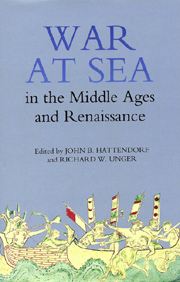Book contents
- Frontmatter
- Contents
- List of illustrations
- List of Contributors
- Preface
- Acknowledgements
- Introduction: Theories of Naval Power: A. T. Mahan and the Naval History of Medieval and Renaissance Europe
- I Northern Europe
- Naval Force in the Viking Age and High Medieval Denmark
- Scandinavian Warships and Naval Power in the Thirteenth and Fourteenth Centuries
- Naval Power and Maritime Technology during the Hundred Years War
- Oars, Sails and Guns: The English and War at Sea, c.1200–c.1500
- II Southern Europe
- III Sixteenth and Early-Seventeenth-Century Europe
- Conclusion: Toward a History of Medieval Sea Power
- Index
- Titles in the series
Naval Force in the Viking Age and High Medieval Denmark
from I - Northern Europe
Published online by Cambridge University Press: 05 April 2013
- Frontmatter
- Contents
- List of illustrations
- List of Contributors
- Preface
- Acknowledgements
- Introduction: Theories of Naval Power: A. T. Mahan and the Naval History of Medieval and Renaissance Europe
- I Northern Europe
- Naval Force in the Viking Age and High Medieval Denmark
- Scandinavian Warships and Naval Power in the Thirteenth and Fourteenth Centuries
- Naval Power and Maritime Technology during the Hundred Years War
- Oars, Sails and Guns: The English and War at Sea, c.1200–c.1500
- II Southern Europe
- III Sixteenth and Early-Seventeenth-Century Europe
- Conclusion: Toward a History of Medieval Sea Power
- Index
- Titles in the series
Summary
THIRTEENTH-CENTURY Scandinavian law codes describe a levy that may be conceived of as a naval militia. Such levies existed in Denmark, Norway and Sweden in similar, though not identical, forms. On the basis of territorial subdivisions into skipæn, districts responsible for supplying a ship, and of these districts into hafnæ responsible for furnishing a member of the crew, the kings of Denmark had, in theory, a fleet of about one thousand ships at their disposal. They had sizeable naval forces but raised them in a unique way, very different from states in the seventeenth century and later.
The age of this organisation, called in Old Norse leiðangr, Danish leding, is disputed, as are the contents of the provincial laws in general. Older generations of scholars were prepared to seek the origins of the laws in a remote Tacitean past while in recent scholarship it has been claimed that they were basically new rules, intended to change the law in Scandinavia, not to record or conserve ancient customary law. It has recently been argued that the code of Jutland was meant to complete and supersede older legislation, like the code of Skåne, and that it was intended as a national law; only the death of Valdemar II in 1241 prevented its raification at all provincial courts.
- Type
- Chapter
- Information
- War at Sea in the Middle Ages and the Renaissance , pp. 25 - 34Publisher: Boydell & BrewerPrint publication year: 2002

